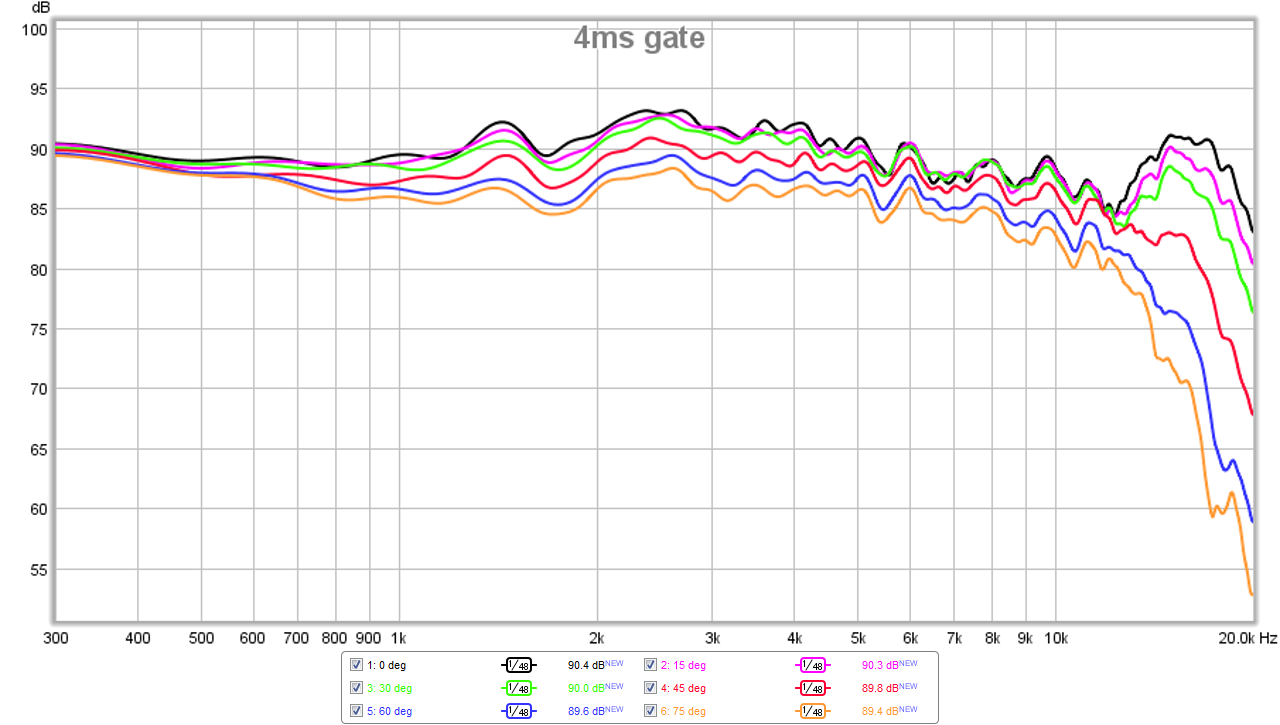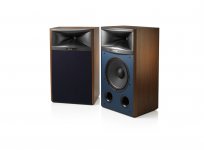Last night I ran them on an AD DSP evaluation board that is putting out ~2*0.4 Watts @ 32 Ohms, highpassed at 1 kHz , third order.
They go definitlely quite loud with that amount of power (as expected) and they do indeed have more "air" (I actually hate that term) than the 2344/2426 combo that I have. I haven't measured them at all yet but from this casual listening test I can say that the do inded need less EQing than the 2344/2426 combo. Also the off-axis reponse is very good.
Regards
Charles
They go definitlely quite loud with that amount of power (as expected) and they do indeed have more "air" (I actually hate that term) than the 2344/2426 combo that I have. I haven't measured them at all yet but from this casual listening test I can say that the do inded need less EQing than the 2344/2426 combo. Also the off-axis reponse is very good.
Regards
Charles
http://www.jblproservice.com/pdf/M2_Studio_Monitor/M2_tech_manual.pdf
Lots of info and discussion here with hands on experience:
http://www.audioheritage.org/vbulletin/showthread.php?33972-JBL-Master-Reference-Monitor
Lots of info and discussion here with hands on experience:
http://www.audioheritage.org/vbulletin/showthread.php?33972-JBL-Master-Reference-Monitor
Last edited:
M2 Master Reference Monitor Products | JBL Professional : yes seems smoother on the blue monitor !
The bass F3 too (or not the same driver?) ! And 12" or 15" on the blue monitor ?!
It looks like more the 7 serie : LSR708i Products | JBL Professional (not the same CD in the 7 serie, but the same as the M2 in the Blue Monitor ? !)
Always liked the blue front grill... très chic !
The bass F3 too (or not the same driver?) ! And 12" or 15" on the blue monitor ?!
It looks like more the 7 serie : LSR708i Products | JBL Professional (not the same CD in the 7 serie, but the same as the M2 in the Blue Monitor ? !)
Always liked the blue front grill... très chic !


Here's some side by sides. Definitely a different waveguide.
When the M2 came out, Geddes made some comments about the 'beak' being a marketing gimmick. (I'm too lazy to dig up the posts, this was a couple of years ago.)
I have a 3D printer, and I figured out how to design the beak in 3D. (I posted that here, again, I'm too lazy to look up my own thread.)
When I measured my waveguide, I found that it measured pretty good, but it wasn't quite as smooth as the QSC, which is still the best waveguide I've every measured.
I've mostly abandoned using the 'beak', except in extraordinary circumstances*, and it looks like JBL has too. I mean, it's "sorta" there in the new waveguide, but it's so small I doubt the effect is any more than cosmetic.
* "the beak" does have it's uses; for instance if you need a waeguide with a wide coverage angle, the beak allows you a deeper throat, which will load the compression driver lower. IE, if you put a JBL D2 on a QSC waveguide, the wide coverage angle of the QSC is going to dictate a shallow waveguide. But the shallowness will hurt your low frequency loading; basically the QSC isn't a good choice if you want to use an xover below 1000hz. Adding the beak to the design makes it deeper, and that loads it lower, while maintaining the wide directivity that you want.
By "beak" do you mean the little ridge or rise in the WG? If so, I think it makes a huge difference and is not cosmetic. Here are my polar measurements of the LSR305, which has a similar WG. It is perhaps one the most uniform polars I have ever measured. +/- 2.5dB variation up to 13kHz at 150 deg wide field, and +/-1.3dB over 90 deg. I would not call that insignificant.

More info here:
http://www.diyaudio.com/forums/full...-rs225-8-fast-ref-monitor-45.html#post4347377
OTOH, the frequency response was not as flat as advertised.

More info here:
http://www.diyaudio.com/forums/full...-rs225-8-fast-ref-monitor-45.html#post4347377
OTOH, the frequency response was not as flat as advertised.
An externally hosted image should be here but it was not working when we last tested it.
The "beak" in the LSR305 is virtually non-existent

The "beak" in the M2 is significant
IMHO, if you want super-smooth polars, you want a suuuuuuuuuper smooth transition from the diaphragm to the exit of the waveguide.

The QSC satisfies this better than just about anything, and I think that's why it's polars are so incredibly smooth
Taken to the extreme, you start to realize that you need to extend this behavior all the way down to the surface of the diaphragm. IE, you have to start thinking about modifying the phase plug.
And once you realize that, you start thinking about using small dome tweeters instead of compression drivers - you eliminate the phase plug entirely.
And THAT is why the LSR 305 is so super smooth I think.
On a side note, I've been getting pretty good polars out of the Sausalito Audio Works lens. Seems to work better with domes than conventional waveguides do.
not anything soft - maybe CVD diamond domes? - otherwise you have ridiculous breakup/modal problems
and a linear single axis piston motion still doesn't give a true spherical wave even with a dome
could even be useful to think of the shape of the dome as a somewhat useful "phase modifying device" re a flat piston front
and a linear single axis piston motion still doesn't give a true spherical wave even with a dome
could even be useful to think of the shape of the dome as a somewhat useful "phase modifying device" re a flat piston front
And once you realize that, you start thinking about using small dome tweeters instead of compression drivers - you eliminate the phase plug entirely.
And THAT is why the LSR 305 is so super smooth I think.
Sounds like a solid argument for the new SEOS8. Have you played with that one?
(Also, check your PM)
It looks like the M2, LSR305, LSR308, LSR705, LSR708 and 4367 waveguides are all designed using the same software, the shape of each of these waveguides (call it break or anything) being directly dictated by the software depending on parameters such as horizontal and vertical directivity, dimensions and shape of the mouth, and wavefront shape at the throat.
There is no "choice" to put breaks or not, and replicating one of these waveguides based on visual clues (let alone drawing conclusions based on these visual clues, or measurements of these replicas) is most probably pointless.
There is no "choice" to put breaks or not, and replicating one of these waveguides based on visual clues (let alone drawing conclusions based on these visual clues, or measurements of these replicas) is most probably pointless.
The M2 waveguide *is* available (and pretty cheap for what it is), so is the D2, and the LSR305 are also available for the price of a single of these waveguides.
So why not just try them instead of guessing?...
So why not just try them instead of guessing?...
More details in the next post...
Hi Patrick, I would like to propose a design change, but first I would like to disparage those who think you are smoking crack, and point out that the obvious thing you would be smoking is pot. More mind expanding, free thinking.
Anyway, the proposal is to use compression, and more importantly, lose slop. First I want you to look at the HF section in the picture with the blue background. There is not a lot of room between the phase plug, and the diaphragm. But the diaphragm is the same as that in the first picture, IE, the same amount of distance between the VC and the edge of the moving part of the diaphragm. This means that the phase plug is covering up part of, or most of, the diaphragm. Now if you look at the picture of the cutaway (this is my picture by the way, did the cutting on the table saw. The hard part was the magnet. And a lot of little fine pieces are stuck all over the place, but I think it is still cool.) to the top right and left of the phase plug, you can see the small ring that the HF comes out of. So the diaphragm is at least 3/8 of an inch across, but the slot it goes through is less than 1/64th.
So my proposed change is to add one or two tweeters, so the ring of tweeters is bigger, and then make the phase plug in the middle bigger, so that it covers most of the inner part of the tweeter ring, with a much smaller aperture for the sound to come out of. I think this will add sensitivity through compression, and give you better response, with less interference from tweeter to tweeter.
The M2 WG is available as replacement part (SKU: 5025594) for 350 usd.
JBL M2 Horn Lens 5025594 - Speaker Exchange
JBL M2 Horn Lens 5025594 - Speaker Exchange
For $350, there's absolutely no value there, particularly if you figure in drivers, labor, DSP, amplification, etc.
JBL sells it direct MUCH cheaper......but you need a serial number to purchase.
I've heard the M2 in a controlled environment studio and for my money, my DIY 3ways with 1" D250, 12" JBL midwoofers and 15" DVC subs certainly gives the M2 a run for the money considering the $20k disparity in price. From a DIY perspective, a synergy/unity design bears much larger and tastier fruit! A sustainable design isn't far off IMO. Hats off to the Danley team for being so supportive of the DIY community.
JBL sells it direct MUCH cheaper......but you need a serial number to purchase.
I've heard the M2 in a controlled environment studio and for my money, my DIY 3ways with 1" D250, 12" JBL midwoofers and 15" DVC subs certainly gives the M2 a run for the money considering the $20k disparity in price. From a DIY perspective, a synergy/unity design bears much larger and tastier fruit! A sustainable design isn't far off IMO. Hats off to the Danley team for being so supportive of the DIY community.
I wonder how the BMS 4592ND would 'behave' in combination with the M2 Waveguide.
Tom Danley, as well as many other manufacturers and scientists (Dr. Geddes, Jean-Michel LeCleach, Wayne Parham etc.), have indeed made invaluable contributions to the DIY community.
Tom Danley, as well as many other manufacturers and scientists (Dr. Geddes, Jean-Michel LeCleach, Wayne Parham etc.), have indeed made invaluable contributions to the DIY community.
Last edited:
For $350, there's absolutely no value there, particularly if you figure in drivers, labor, DSP, amplification, etc.
prudent shopping you can get a new M2 direct from authorized dealer for $4k each + amplification/dsp of course. Crown IT 4x3500 = $6k.
WG $350
D2430K $355
2416ND $560
Horn Flange $120
$1385 + Highpass crossover $175(can be done for much less of course)
+ Box and finish....oh, and ports, I have not seen the ports offered.
Any phase plots for the M2?
Last edited:
- Home
- Loudspeakers
- Multi-Way
- JBL M2 for The Poors

